Bhutan, Nepal & the Mystical Himalayas
October 5-27, 2011
NEPAL - October 13-27, 2011
Page Four - Kathmandu and Bhaktapur
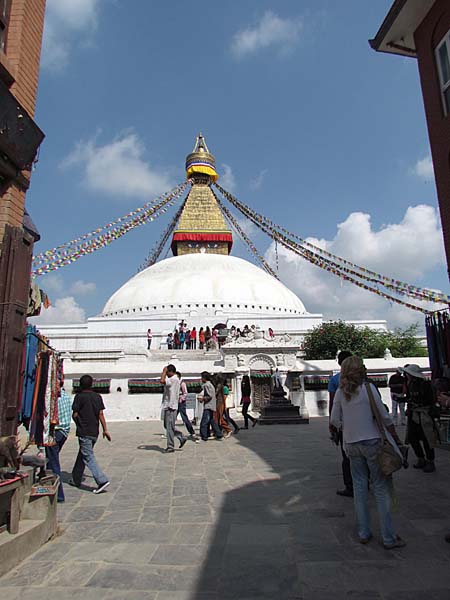
Bodhnath Temple in Kathmandu, the largest stupa in Nepal and one of the largest in the world. It is the religious center for Nepal's
large population of Tibetans, and there are Tibetan monasteries surrounding this stupa. Many of the Nepalese Tibetans are refugees
who fled their country after the unsuccessful uprising against the Chinese in 1959. Bodhnath is associated with Lhasa and Tibetan Buddhism.
Bodhnath is located at the historic Tibetan traders' entry to Kathmandu.
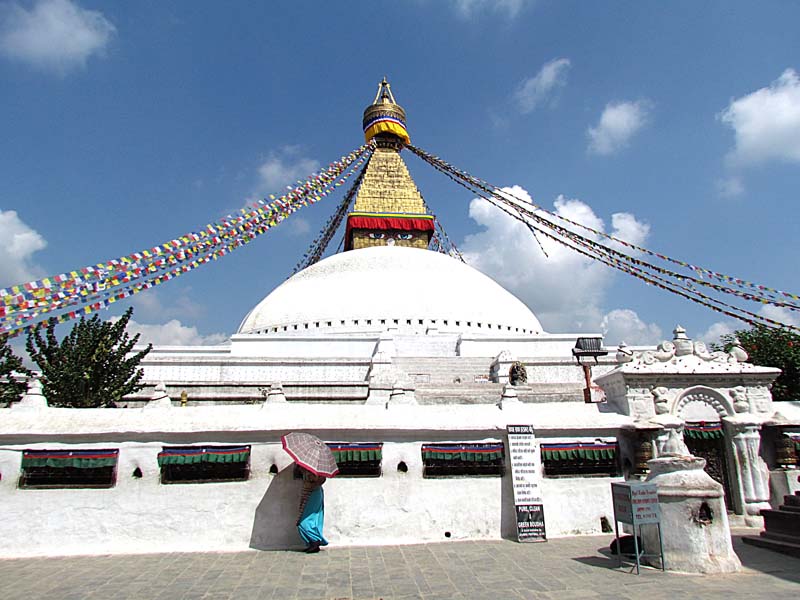
Bodhnath Stupa was probably built shortly after 600 AD. The current stupa has probably been in existence since the 14th century. Stupas
were originally built to house religious relics or to commemorate an event or place. They are never hollow. The base of this stupa has the shape
of a mandala, symbolizing earth. On the 4 tiered base sits the dome, symbolizing water. The spire symbolizes fire. The umbrella above the spire
symbolizes air, and the pinnacle symbolizes ether. The Buddha's watchful eyes are seen in all 4 directions. The third eye is between and above the
2 normal eyes. What looks like a nose is actually the Nepali number one, signifying the unity of all life. The spire is 13 steps, representing
the 13 stages on the journey to nirvana. The brick wall around the stupa has 147 niches, each with 4 or 5 prayer wheels bearing the mantra
"om mani padme hum."
One is supposed to walk around stupas as well as prayer wheels in a clockwise direction.
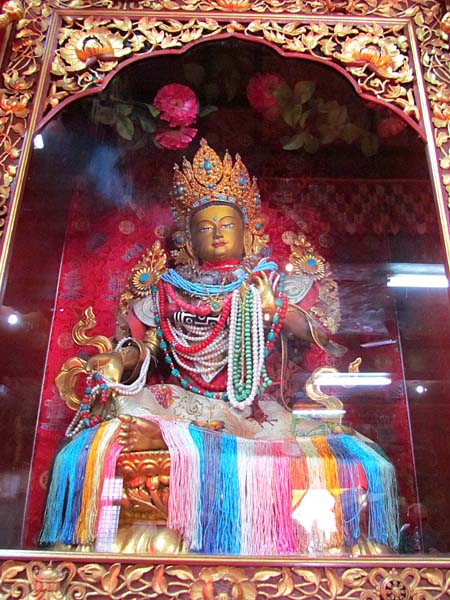
There are a number of gompas or monasteries surrounding Bodhnath that you can see inside. Here is a statue of a Buddha inside one of them.
The influx of large populations of Tibetan refugees from China has resulted in the construction of over 50 Tibetan Gompas around Bodhnath.
These monasteries are highly decorated with colorful mural paintings and statues.
Tibetans believe Buddha has been reincarnated many times.
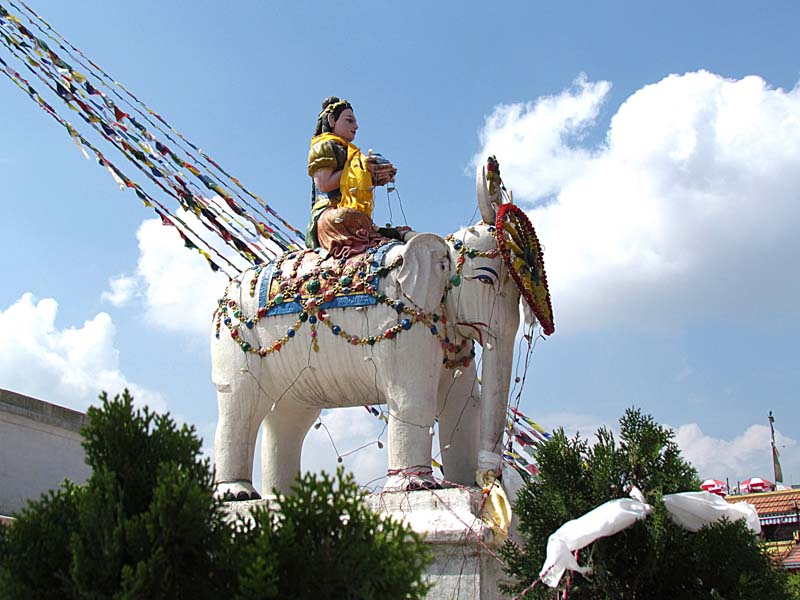
Highly decorated elephant bearing a Buddha
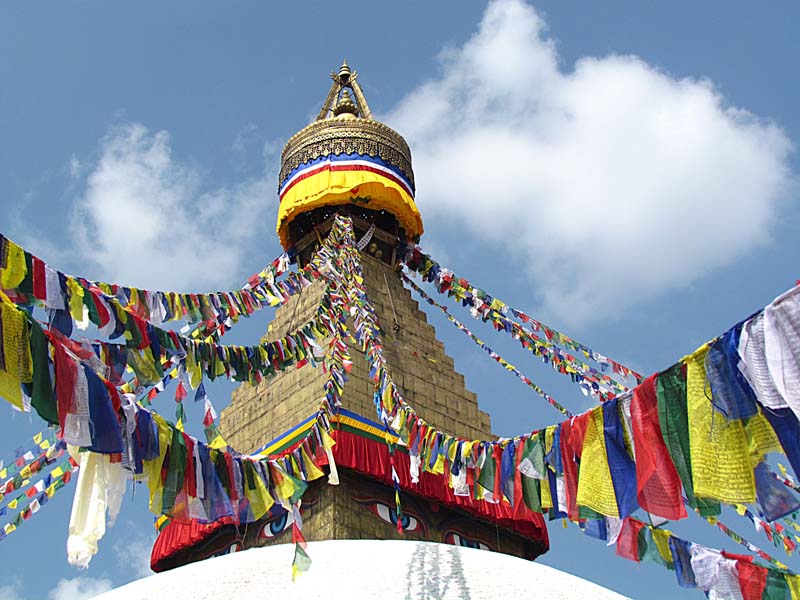
Prayer flags on Bodhnath stupa. We saw a smaller stupa in Bhutan that was modelled after this one.
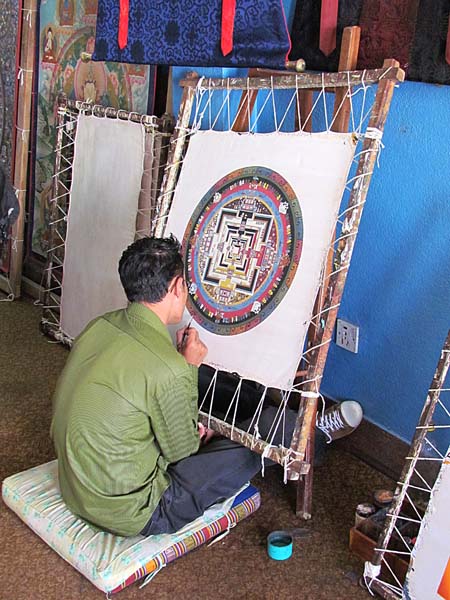
A student doing a Thanka painting at a school in the circle of structures around Bodhnath.
They consist of a picture panel which is painted or embroidered, over which a textile is mounted, and then over which is laid a cover.
The art of Thanka painting is very old and was practiced as early as 3rd century B.C. in Tibet. Thankas are fine paintings which are made with
great concentration by hand. The tradition of Thanka painting is not confined to the Tibetan community. Those who adopted Tibetan
Buddhism may learn this art. These colorful paintings generally represent Buddhist and Hindu Gods, Goddesses, meditating Buddha
and his life cycle, Wheel of Life, Mandala, Bhairab, Exotic pictures, etc. As Thankas are ritual paintings, most people never
considered the Thankas as an object of decoration. But nowadays Thankas are gaining popularity as a decorative item all
over the world. Usually painted on cotton cloth, more rarely on silk, colors are traditionally made from minerals as well as vegetable
dyes, but now artists also use modern synthetic dyes, silver and gold. Generally, thankas last a long time and retain much of their luster,
but because of their delicate nature, they have to be kept in dry places where moisture won't affect the quality of the silk.
Originally, thanka painting became popular among traveling monks because the scroll paintings were easily rolled and
transported from monastery to monastery. The thanka served as important teaching tools depicting the life of the Buddha, various influential
lamas, and other deities. To Buddhists these Tibetan religious paintings offer a beautiful manifestation of the divine, being both visually and
mentally stimulating. Overall, and perhaps most importantly, religious art is used as a meditation tool to help
bring one further along the path to enlightenment.
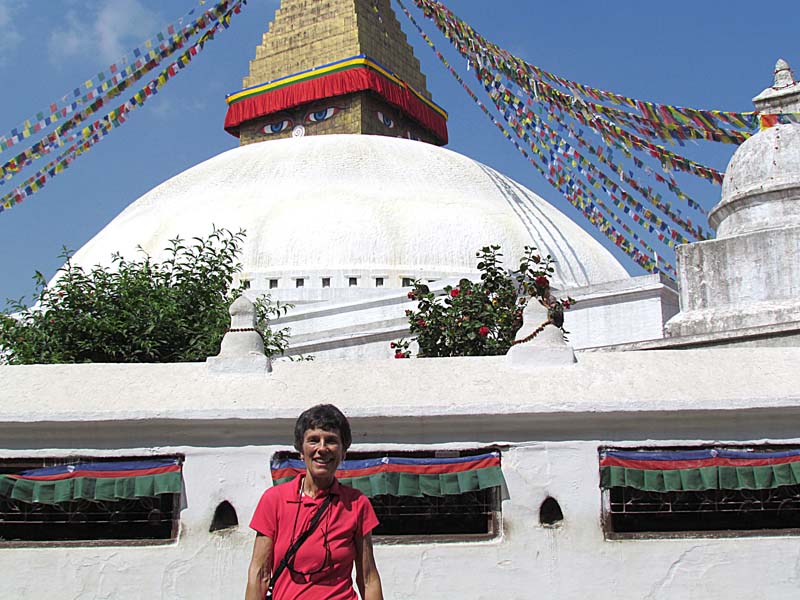
Pat at Bodhnath Temple. You can somewhat see the 3rd eye between the 2 normal eyes and the Nepalese number one that looks
like the nose.
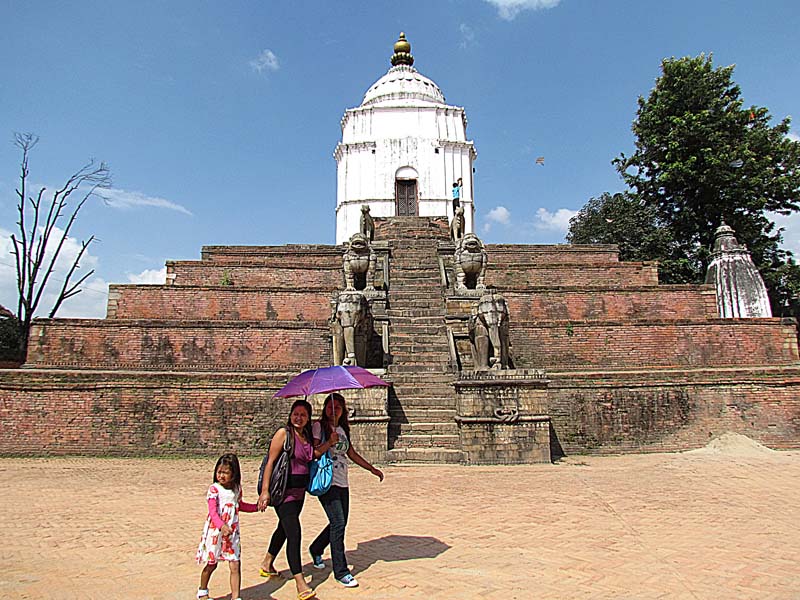
At Bhaktapur Durbar Square, Fasidega Temple dedicated to the Hindu god Shiva. Bhaktapur, also known as Bhadgaon or the City of
Devotees, is the 3rd major town of Kathmandu Valley (Patan and Kathmandu are the other 2). It's been a cleaner town than the other 2
ever since a German-funded Bhaktapur Development
project in the 1970s. Bhaktapur was the capital of the Kathmandu valley
from the 14th to 16th centuries. Much of the town's great
architecture dates from the end of the 17th century
during the rule of King Bhupatindra Malla.
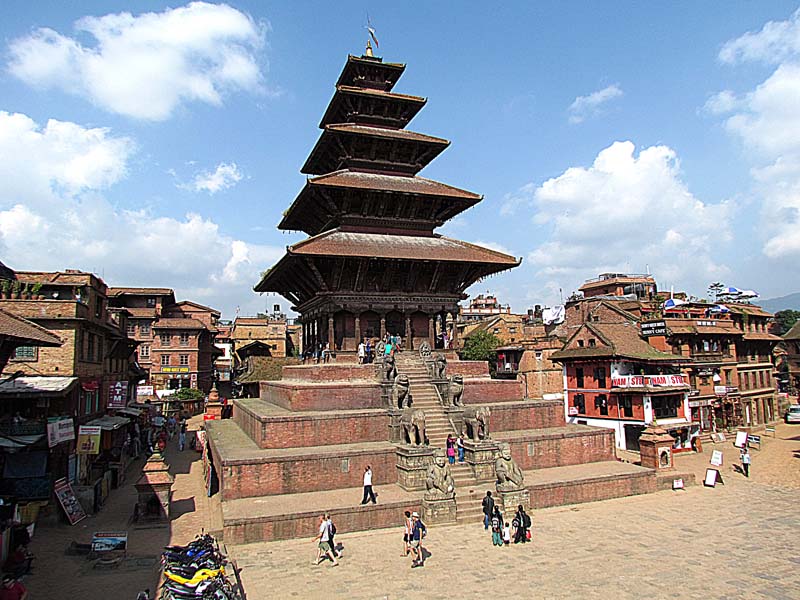
Nyatapola Temple in Bhaktapur Durbar Square with a 5-story pagoda. This is the highest temple in Kathmandu Valley, and a good
example of traditional Nepali temple architecture. It was built during the reign of King Bhupatindra Malla in 1702 and was so well built
that it largely withstood a major 1934 earthquake. The stairway up to the temple is flanked by guardian figures at each level. The bottom
level has legendary wrestlers Jayamel and Phattu, said to have the strength of 10 men. One level up are 2 elephants, then 2 lions, then
2 griffins (with body of a lion and head of an eagle), and finally 2 goddesses.
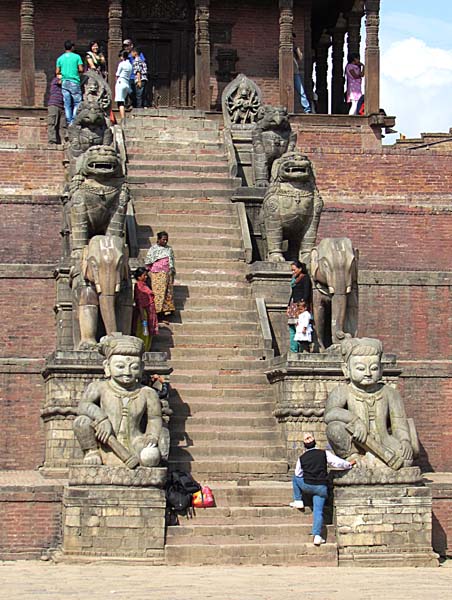
A closeup view of the guardian figures of Nyatapola Temple in Bhaktapur Durbar Square
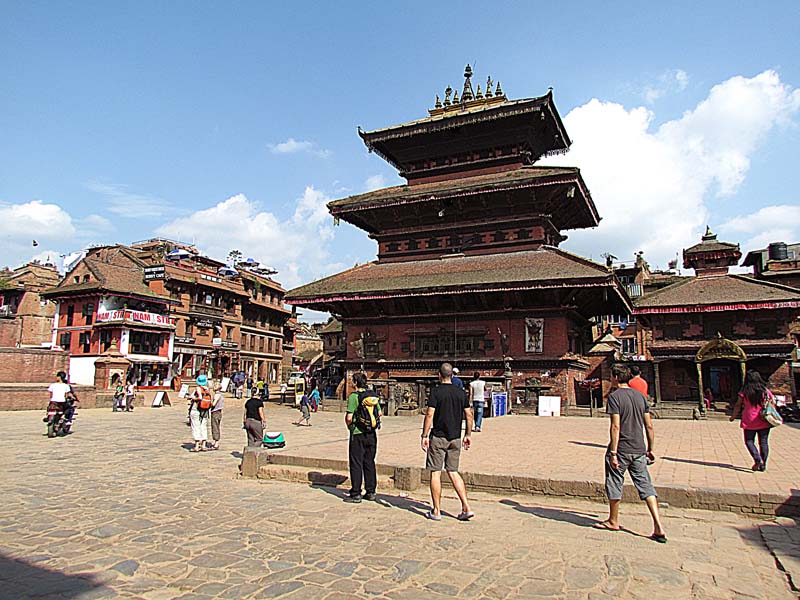
Another temple at Bhaktapur Durbar Square near Nyatapola Temple, called the Bhairabnath Temple
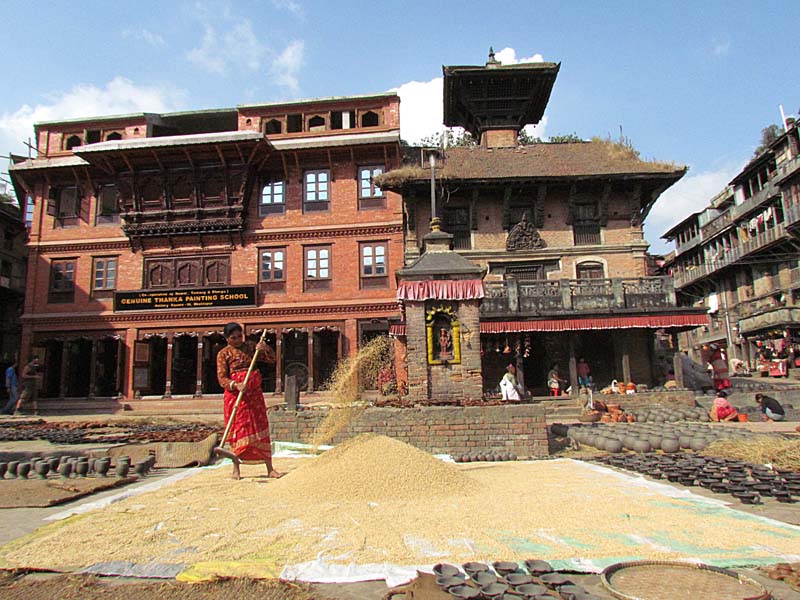
A woman drying rice in Potter's Square near Durbar Square in Bhaktapur
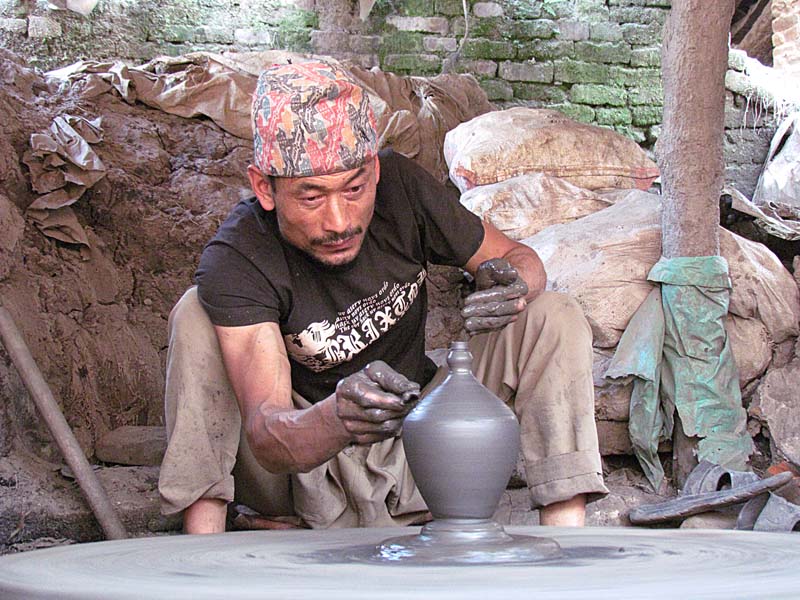
A potter in Potter's Square demonstrating his art to us
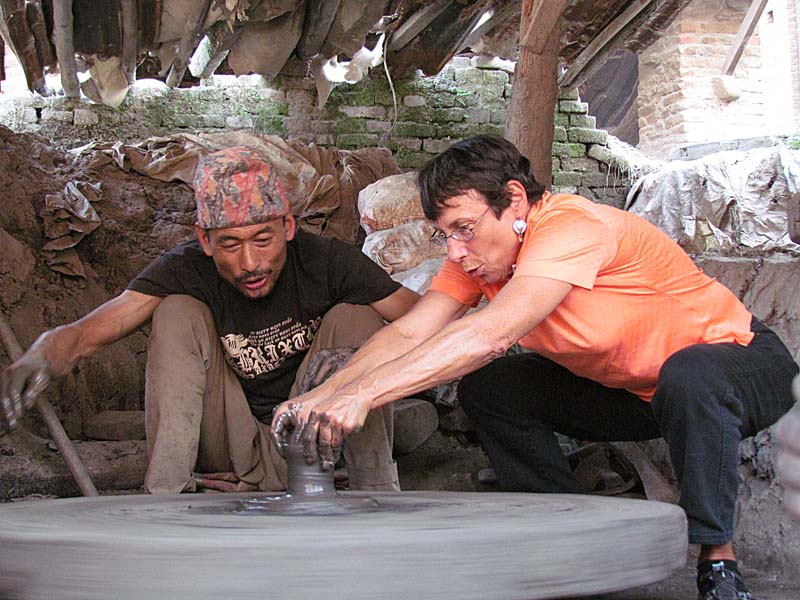
Jill from our group making an effort to create pottery with the expert's help.
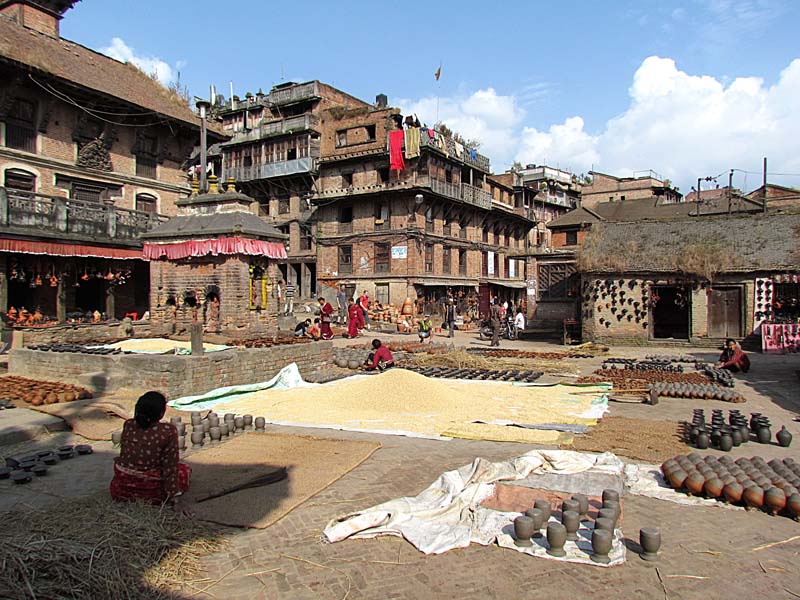
Overview of Potter's Square with pottery drying in the sun
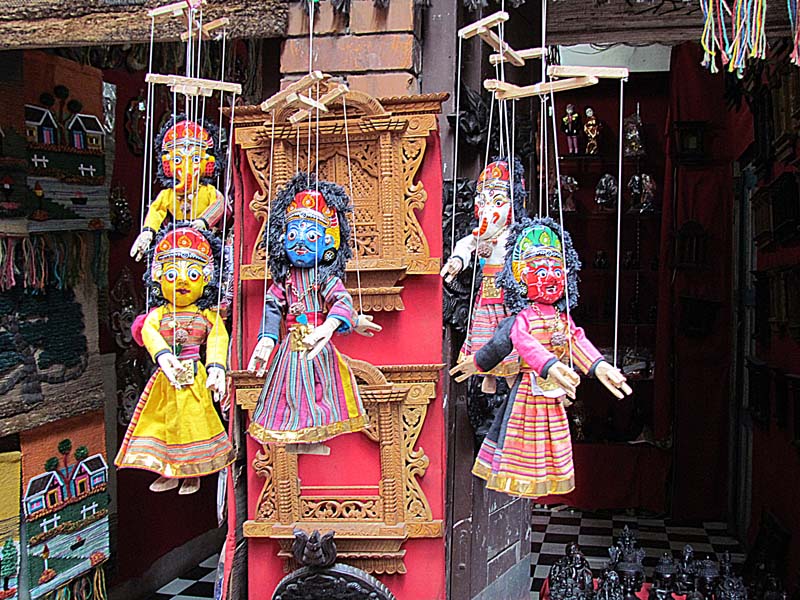
You see lots of puppets for sale in Nepal like these puppets
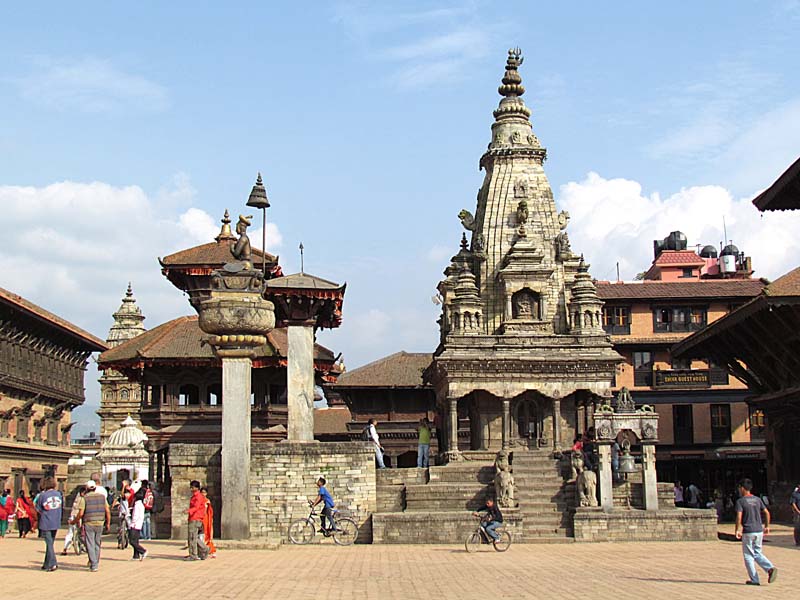
King Bhupatindra Malla's Column in Durbar Square. The King's statue faces the Golden Gate, to the left of this photo
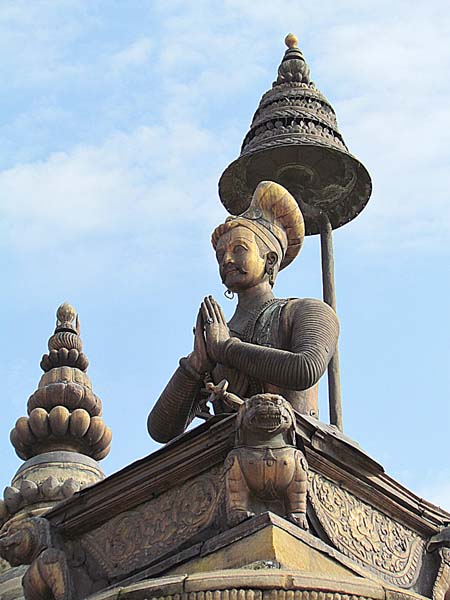
The King's statue in the main square of Bhaktapur
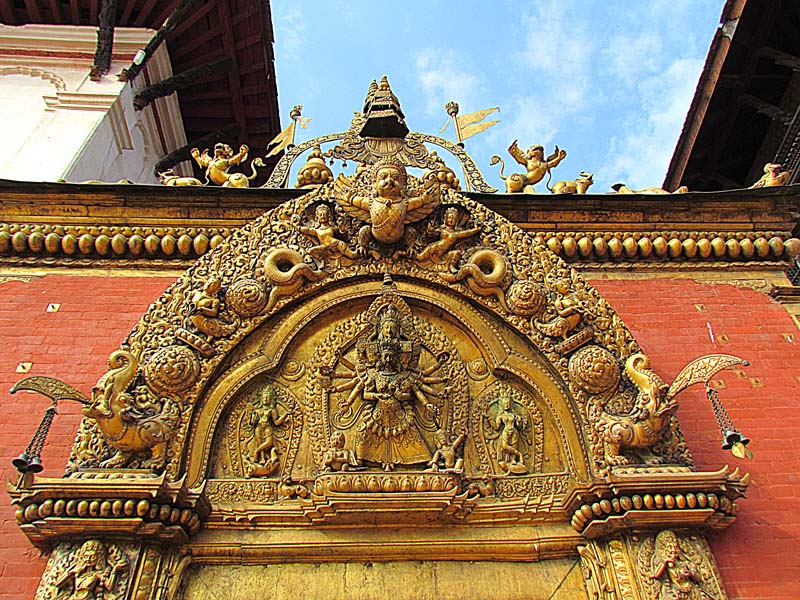
Top of the Golden Gate, or Sun Dhoka, the entrance to the 55 Window Palace of Bhaktapur's Royal Palace. This gate and palace were
built by King Bhupatindra Malla but not completed until 1754 during the reign of a different Malla king. A Garuda, the vehicle of the god Vishnu,
is at the top of the gate. A Garuda is a birdlike creature in the Hindu religion,
usually the mount of the god Vishnu.
He is shown here disposing of a number of serpents. The Golden Gate opens to the inner courtyards of the Palace.
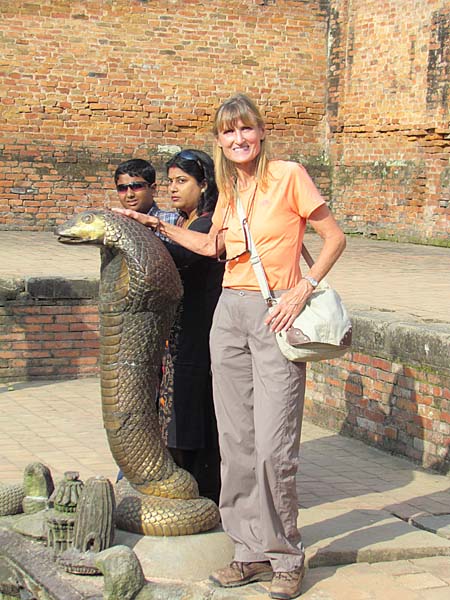
Kylee from our group with a Naga at Bhaktapur inside the Palace. Snakes appear frequently in Hindu and Buddhist mythology in Nepal.
Snakes are thought to have power over water, so they are important for ensuring a good monsoon season.
According to mythology, the Kathmandu Valley was originally a lake known as Nagadaha
that was full of snakes (naga: snake deity, daha: lake).
The myth states it was drained by a Buddhist
sage who had come for meditation.
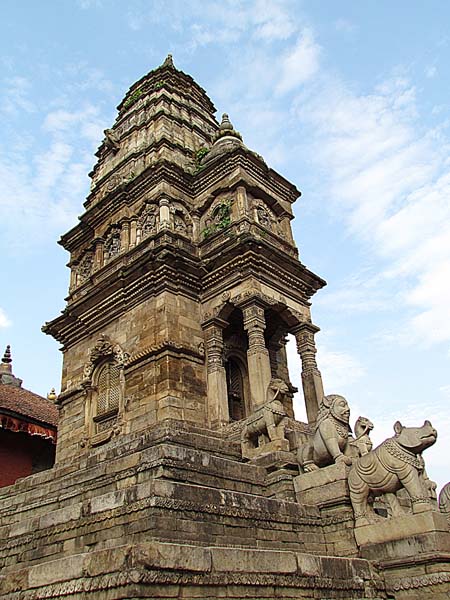
More guardians, including a one-horned rhinoceros at a temple in Bhaktapur Durbar Square
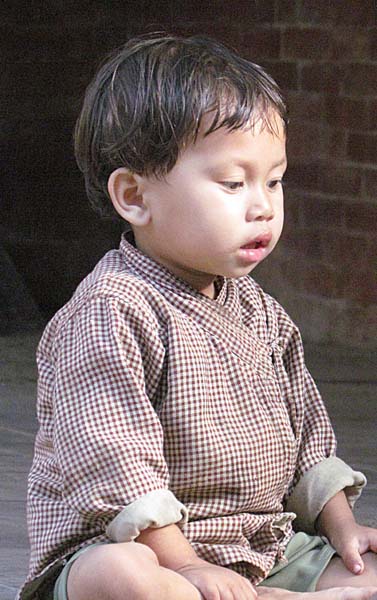
Small boy who was sitting next to his mother who was selling fruit on the street
leading away from Bhaktapur Durbar Square
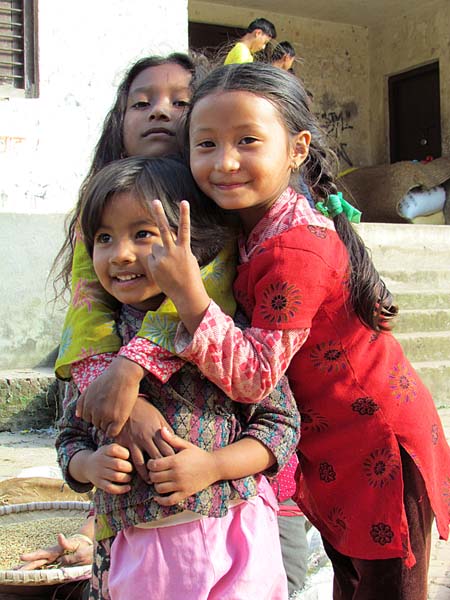
3 girls who were eager to pose for us as we were leaving Bhaktapur
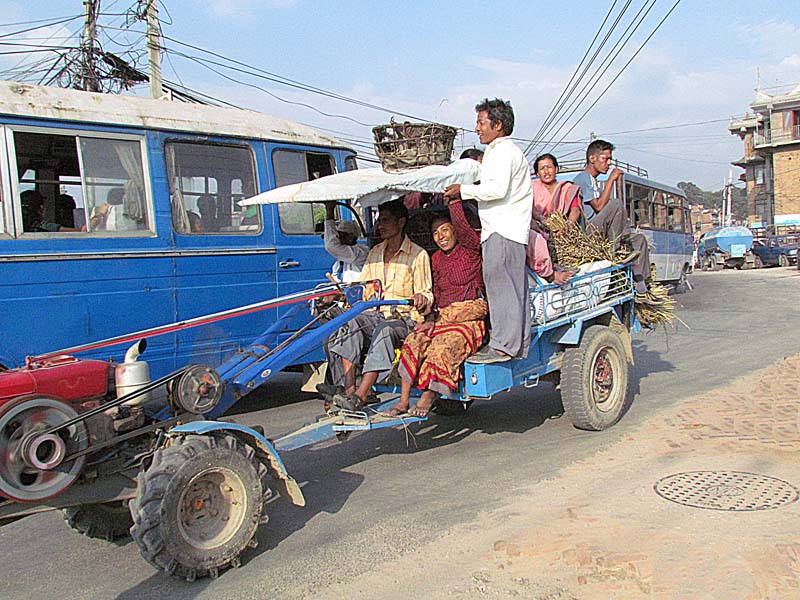
Farm workers being transported from the fields
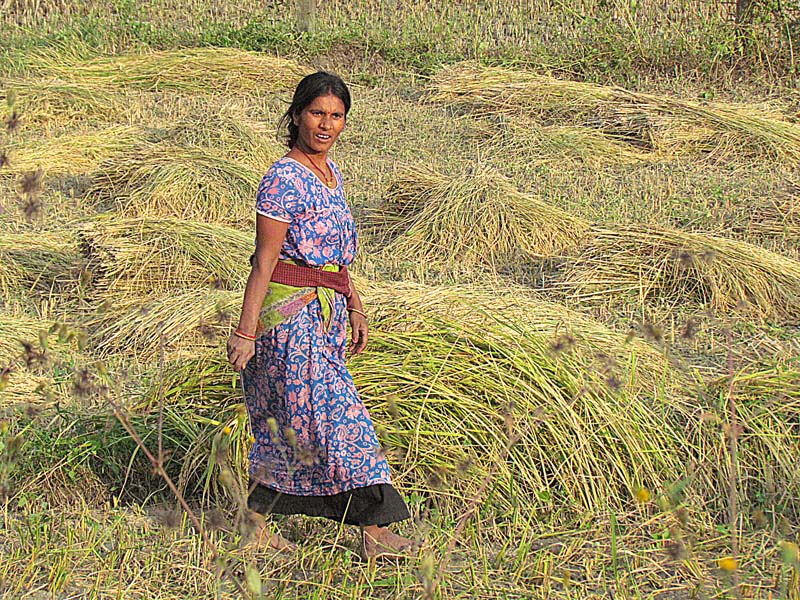
A farm worker in a field along the road we were traveling. The Newars, origin unknown, form the largest single group of people
in Kathmandu valley,
but immigrants from around the
country have come to the valley in search of jobs and education,
so there are significant minorities of almost every Nepali ethnic group, plus thousands of Tibetan refugees.The Newars are divided into
castes,
whether they consider themselves Hindu or Buddhist. Caste rules
are not as rigid as some parts of India,
but intermarriage is still unusual. Arranged marriages are still typical in Nepal.
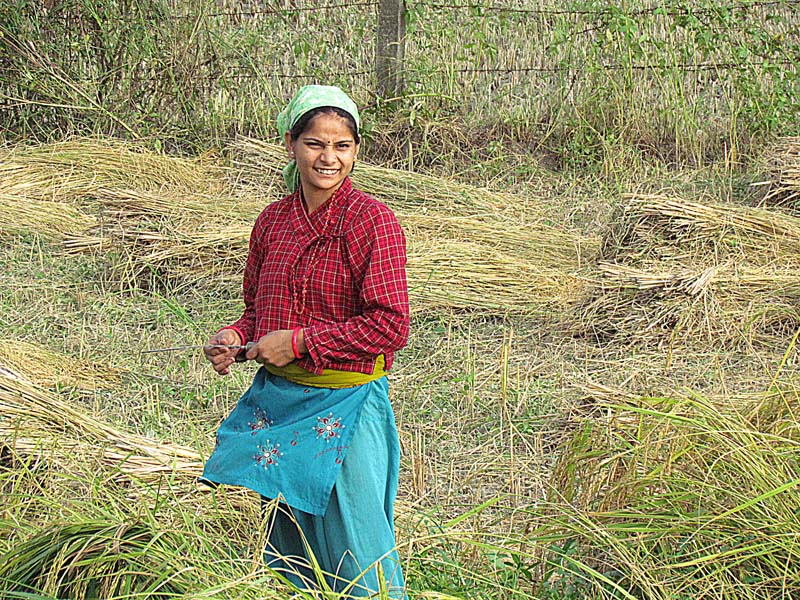
Another field worker in Kathmandu Valley -The Nepalese are descendants of three major migrations from India, Tibet, and central Asia.
Link to Page Five of Nepal - Annapurna Range
Link to Page One of Nepal
Pat's Home Page